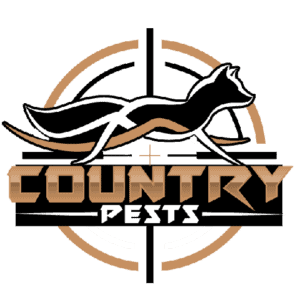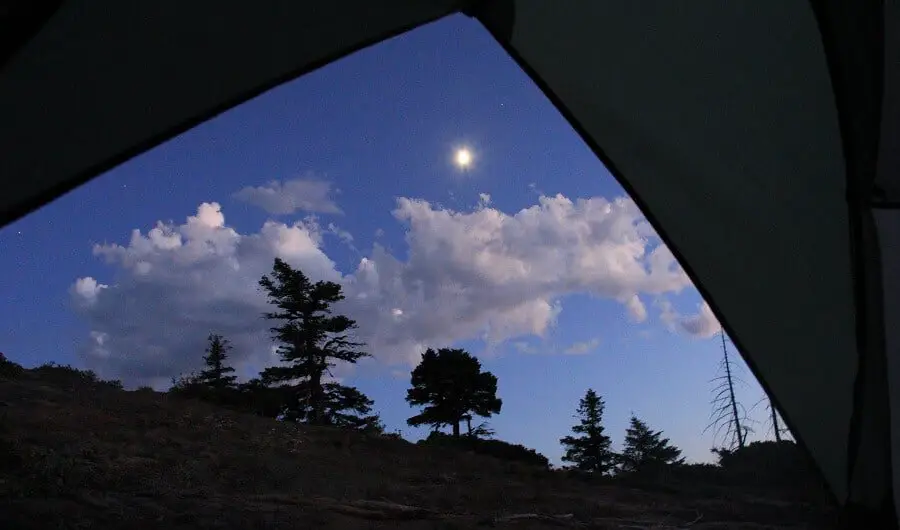Camping and backpacking are one of our most beloved pastimes. It offers us a chance to experience nature, to conquer challenges, and learn. The very things that attract us also offer us challenges. In many parts of the United States, bears have increased in population. Around the world, bears can be found on every continent.
Protecting your food from bears becomes very important.
Why Should We Protect Food From Bears While Camping Or Backpacking?
Most people think that keeping food safe is for people’s benefit. If a bear or another animal eats your food, you won’t have enough and may have to cut your trip short. But, that is only a minor reason to keep food from animals.
Human food has a stronger scent and flavor than natural habitat food. When bears and mini bears taste human food, they develop a taste for it. This makes them less willing to forage or work for natural food.
People food does not meet the nutritional needs of animals. Even if wildlife could have access to people food on a consistent basis, it would harm their health. In some cases, wildlife becomes dependant on people food and ceases to live a natural life. Those animals then starve to death when winter hits and visitors stop coming by.
But the bigger danger is that wildlife that associates humans with food becomes a nuisance. Bears that become too people friendly are dangerous to people. They are more likely to search out campsites for an easy meal. When bears lose their fear of people, they are more likely to harm or attack a person.
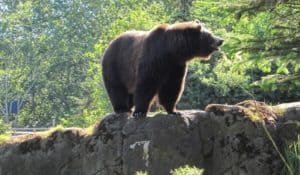
Problem bears eventually have to be dealt with through relocation or death. This is costly and it is tragic for the bear, especially if it is euthanized.
Bears that lose their fear of people have a lower life expectancy than other bears. They are more likely to be poached, hurt by accident, or euthanized.
Campers, hikers, and backpackers are visitors to the wilderness. We must do our part to protect the existing inhabitants from danger. This will also help to protect future visitors. The fewer wildlife associates humans to free benefits, the more we can all safely enjoy nature.
- Protect Your Trip By Keeping Your Food Safe
- Bears Can Grow To Prefer Human Food Over Natural Food
- Natural Food Is Nutritionally Better For Bears And Wildlife Than Human Products
- Wildlife Becomes Dependant On Human Food
- Bears without fear of people have shorter life expectancies
- Bears become problems and have to be “dealt” with
- Bears become dangerous to hikers and campers
- The authenticity of the wilderness becomes compromised
These are only a few of the many problems that come from sharing your food with wildlife. Whether on purpose of by accident, human food compromises the health and safety of the animals themselves.
Then, the question becomes, “How do I keep my food safe?”
Do I Need To Protect My Food If There Are No Bears?
No matter where you camp, you should keep your food safe from either bears or mini bears. Even in areas that aren’t bear habitats, mini bears can get into food, destroy it, or equipment, and spread disease.
It’s essential for campers to be aware of the areas they visit so that they can take the essential steps to protect human products from local animals.
What Are Mini Bears?
Mini bears include all small animals that can steal your food. Mini bears include mice, rats, squirrels, chipmunks, raccoons, rabbits, marmots, pikas, porcupines, and birds.
- Mice, rats, and marmots
- Squirrels and chipmunks
- Raccoons
- Rabbits and pikas
- Porcupines
- Birds
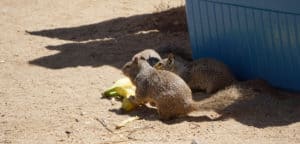
Photo credit: Tracie Hall Flickr
Mini bears can carry disease and illness, not only for humans but for the other wildlife population. When mini bears congregate to popular camping sites, it spreads illness among the animal population at a greater pace than in the wild. This causes issues in the local habitats and can wreak havoc in animal populations.
Some of those illnesses can carry to the human population can wreak havoc with individual campers. In other cases, humans become carriers of illnesses and spread them to other parts of the wilderness.
Human dependence also naturally increase a localized population of mini bears. This throws off the ecosystem. It also means mass starvation during winter months when human visitors stop coming to the area.
It is inconvenient to hikers to have a backpack chewed through, gear stolen, or food missing. It often means cutting a backpacking trip short. Or, at best, a huge inconvenience.
- Mini bears spread disease and illness to the local animal population
- Illness can sometimes be spread to humans
- Humans can become carriers of illness and spread it to another area
- Mini bear population grows unnaturally throwing off the ecosystem
- Starvation becomes rampant when humans withdraw from an area for the winter
- Inconvenience to hikers when gear is stolen or destroyed.
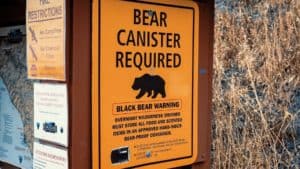 A
A
Types Of “Food” That Should Be Protected: Foods That Attract Bears
It is important to protect any human products that have a strong scent from bears and other animals. Wildlife cant distinguish between bacon and smelly cologne or toothpaste. Human products are especially strong scented to animals because they haven’t been conditioned to be used to the smells and scents that we take for granted without noticing.
You should also remember that pet food will attract bears and mini bears. Human urine will attract animals. Cosmetics, insect repellent, toiletries, and garbage are also attractions. Cooking utensils, cooking oil, and fuel can attract bears to a campsite.
All of these types of “food” should be protected while camping.
- Human and pet food
- Toiletries: shampoos, soaps, deodorant, toothpaste, and mouthwash
- Cosmetics: perfume, cologne, lotions and other smelly products
- Cooking supplies: Stoves, pots, pans, and utensils
- Cooking oil and fuel oil
- Unopened canned beverages
- Insect repellant
- Coffee grounds
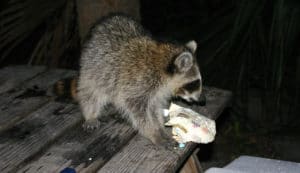
Photo credit: Kai Schreiber Flickr
While you probably don’t want to leave the sunscreen, toothpaste, or cooking supplies at home, there are things you can do to reduce the attraction to bears. Consider using natural and biodegradable products. Go scentless. Use scentless deodorant and lotion. Skip the cologne.
Thoroughly clean dishes and stove after every meal. Protect food and scented products from bears and mini bears.
- Use natural and biodegradable products
- Use scentless products
- Leave home all non-essential products
- Clean dishes and cooking tools after every meal
- Take other precautions to keep food and products safe
What’s The Best Way To Keep Food Safe From Bears And Mini Bears?
When camping or backpacking, there are several precautions you should take to protect food. Not all of these steps are necessary. It’s important to know about the area you will be visiting.
Talk to a ranger or previous visitor to the area. Read the signs posted and be aware. The number of steps you should take will depend on the level of wildlife activity and whether you are trying to keep human products from bears or mini bears.
1. Avoid Campsites And Area With Recent Bear Activity
First, be conscientious when camping. Know what areas are in the middle of bear country.
Most campgrounds will post or tell you if there has been recent bear activity. Be mindful of where you will be camping and plan accordingly. If you are staying in bear country, plan extra precautions to keep bears away from your food.
If you are backpacking, be aware of where you are staying. Some of the very picturesque places that you may want to hunker down for the night are the same places that bears like to hang out. Near rivers, in a cave or nook, and other areas. Watch for bear scat, claw marks on trees, and tracks.
Bears are generally shy. They don’t want contact with people unless they have been conditioned to seek food. So, if you see bear signs in an area, don’t camp there. Move to another area.
Be careful of caves and other animal trails. Bears like to use the same trails over and over again. If you find a trail that requires you to duck to follow it, then it is likely a bear trail. Bear trails usually tunnel through the forest and bushes about waist high.
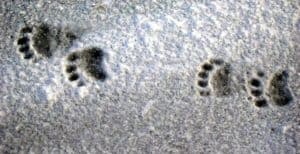
Photo Credit: Photo by Heather Crawford from FreeImages
2. Use Existing Bear Infrastructure To Store Food
High traffic campgrounds that also have high populations of bears around usually offer infrastructure to help people keep food away from bears.
Make use of existing tools. Bear boxes are designed to keep food from bears. They are hard metal boxes.
Everything that smells should be kept in the bear box. I’ve seen bear boxes in Yellowstone National Park, Calavera Big Tree State Park, CA, and many other national parks around the USA.
In other campgrounds, cable, pole and cross-beam systems are available to help campers keep bears away from their food and other products.
Poles are usually tall poles with coat rack-like hooks. You use a branch to hang your backpack onto the hooks. These don’t work well in grizzly bear country because grizzlies can climb trees well.
The cable system has a series of loops on a large cable. You attach your bag to the loops. Then, use the cable to pull your stuff high. Then, secure it with a bear-proof carabiner.
Make use of these existing tools. Remember to store everything and leave nothing out, even dirty dishes.

3. Use Cooking Safety To Keep Bears Away
Smell is the main thing that attracts bears to people. When camping or hiking through bear country, make sure that you cook in separate clothing than you sleep in. Plus, cook at least 200 feet and downwind from your camping spot.
The smell from cooking and eating will move away from your sleeping area and bears will be much less likely to find you.
And, changing your clothing after you cook is also important. If you’ve hidden all the food, but still smell like food, a tent isn’t going to keep you safe.
The most important thing is to make sure that you don’t leave anything that will attract bears. This includes cleaning up and putting away the camp stove, trash, and pots and pans. Keep food waste away from your tents and apply the same steps you take with food to keep bears and mini bears away.
- Change clothing after you cook and keep cooking clothes away from the tent
- Cook at least 200 feet downwind of the campsite
- Clean up all cooking supplies campfire, dishes, pans, etc
- Clean stove and store all food items, including cooking oil and fuel
4. Make Use Of Hard-Sided Vehicles To Store Supplies
This trick doesn’t help backpackers as much as campers. Keep food, toiletries, and other smelly products inside of a hard-sided vehicle. Keep the windows rolled up.
This will help to contain the smell from the products and to keep animals out.
Remember that raccoons, mice, bees, and other small animals can easily get through a cracked window.
These mini bears can wreak havoc on your supplies and make a huge mess.
Bears are also less likely to smell food that is contained inside a car.
5. Avoid Bright Colored Tents
In popular camping areas, bears have learned to associate bright colors with people. Nature usually produces greens and browns. Bring along a less ovbious tent. A dull-colored tent helps you to blend into the area.
This keeps bears from visually identifying your campsite. If you then store and cook your food downwind of your site, then you will remain nearly invisible to any bears in the area.

Photo credit: Flickr Mandy Goldberg
6. Keep Your Garbage and Fire Clean
While most people remember to properly store their foodstuff, many forget about their garbage or campfire.
The campfire can be a great place for unwanted food scraps to attract bears. Keep your fire clean by throwing away all food scraps. Burned food will help your smoke to attract more animals from a farther distance.
And, the remaining food becomes an easy meal for foraging animals.
Likewise, garbage should be securely stored. Bears and mini bears don’t care if your food is garbage or wrappers. They will get into it just as fast.
7. Use Bear Canisters For The Best Food Protection
In many parks and campgrounds, bear canisters are the only acceptable way to store food away from bears. When used properly, bear canisters keep bears from accessing anything inside and will contain the smell.
Bear canisters are hard-sided containers. They usually require a coin or a screwdriver to open the lid. Some are clear so you can see what you have stored in them.
Bear canisters are designed to keep a bear from running away with your food. They are large enough that a bear can’t get his mouth around it and carry it off.
It’s important to remember that you shouldn’t store your canister in your pack or the bear will run off with your pack and canister while you are sleeping.
Bear canisters don’t have to be hung. They are usually sturdy enough to use as a seat and most of them fit in a backpack.
But, they are bulky and add 2-3 pounds to your backpack. This makes them less than ideal for many backpackers.
Even as you eat your food, the canister will still use the same amount of space. But that also protects food that can be easily crushed.
Still, before you consider going without one, make sure that other options are ok. In bear country, a bear canister is often the only allowed option to store food. If you are caught without one, you will probably be fined a very hefty fine.
Some national parks will rent them out, but the sizes and supplies are often limited.
- Canisters are bulky and add weight to your supplies
- Canisters are bear proof
- Sturdy enough to double as a seat
- Keeps food from being broken or smashed
- Only allowed option in many national parks in the West
- Don’t need to be hung from a tree
- Do not attach anything to the canister. This allows it to be carried off.
- Do not put near a cliff or hill where it can be rolled down to break
Bear canisters can be used for trash and will keep the contents from spilling into your pack. Do not substitute another method for a bear canister if canisters are required.

Photo credit: Flickr Matt Zimmerman
7. Employ Soft Bear Proof Bags In Less Dense Bear Areas
Ursak is the most popular and most tested bear bag. It is made from Spectra fabric and won’t tear or rip.
For backpackers, the Ursak is a great option because it weighs less than half a pound. It can be scrunched up and holds a lot of food. That makes it convenient to store toiletries in as well.
The Ursak has some funny videos of their testing it with bears.
But, there are a few cons with the Ursak as well. First, if a bear does find the bag, it won’t protect your stuff from being crushed. The Ursak is flexible and easy to fit in a backpack, but it doesn’t have hard sides.
So your crackers, cookies, and other supplies can be crushed to crumbs.
Another disadvantage is that the smell still escapes the Ursak. Bears can smell food stored in and even though they can’t gain access to it, they may be attracted to the area.
- Ursak is lightweight
- Ursak is flexible and scrunches
- The tear-proof fabric keeps food inside the sack
- Ursak allows smells to escape and can still attract animals
- Food can be crushed or smashed while bears try to get into the sack
Hang A Bear Bag To Protect Food
In areas with lower populations of bears, a bear bag may be an acceptable option for storing food away from bears.
But, it is usually only allowed in areas with very few bears. That’s because most people don’t know how to hang a bear bag correctly and will usually make several mistakes. Bears will be able to access the food, which causes many problems.
Bear bags should be hung 200 feet away from the camping site. They should also be hung away from the area that you cooked in.
Bear bags need to be hung at least 12 feet off the ground and 8 feet away from the trunk of a tree. That’s because bears can climb trees.
The bag will also need to be hung at least 4 feet below the limb of the tree. The bag should be far enough out on the limb to support the bear bag, but not the weight of a bear.
You need at least 50-100 feet of cord per bear bag. You may also want to have a carabiner, which makes it easier to hang the bag.
- Hanging a bear bag can be time-consuming
- It is the least preferred method to protect food from bears
- Supplies: Carabiner and 50-100+ feet of rope, depending on the method chosen
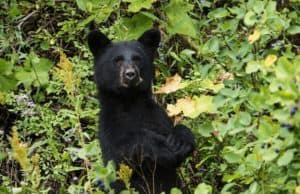
How To Choose A Tree And Hang A Bear Bag Rope
- Create a counterweight on one end of your rope.
- Tie a rock to the rope by wrapping the rope and tying it around the rock
- Attach a small bag with weight to the end of the rope.
- The bag can have dirt, rocks, or other weight in it
- Identify a tree to hang the bear bag from
- The location should be away from the sleeping area and away from the cooking area
- The branch should be high and extend beyond the trunk of the tree
- The limb should be at least 15 feet his so that the bag can hang 4 feet below it and 10 feet above the ground
- Throw the weight over the branch
- If the weight isn’t enough to bring the rope down, toss some rope up toward the branch a little at a time.
- This will allow the weight to bring the rope down a little with each toss until the weight is back down where you can reach it.
- If rope won’t budge or the tree snags the rope, try a different rope or tree branch.
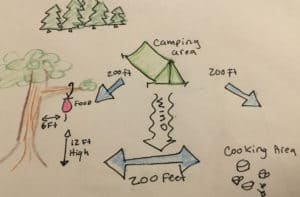
How To Hang A Bear Bag Using The Straight Hang Method
The straight hang method is the easiest way to hang a bear bag. But, it is also the least effective. It hangs a bag from a tree directly below the branch and away from the trunk.
In some areas, bears can easily crawl out to the tree branch and pull tug and upset the rope. This can cause it to fall off the tree branch, cut the rope, or undo the rope.
Many bears have figured out that the tied rope securing the bag is related to the bag. They know that by chewing through that rope, it will allow the bag to crash down. They don’t even need to climb a tree to access your food.
The bear bag falls to the ground, and the bear has full access to your food and other items.
This method is best used to protect food from mini bears and during the day. It isn’t the best method to use at night when you aren’t able to keep an eye on it and jump in to rescue your food.
This method is also called the rodent hang method. If you are using it in a place without bears and you just need to protect your food from mini bears, then you can also use a heavy-duty fishing line on the end of your rope. Rodents can’t climb fishing line and so your rodent hang will be more effective than using a rope.
Steps To Hang The Straight Method Bear Bag Or Rodent Hang
- Throw the rope and weight over the end of a tree branch
- Attach a carabiner to the end of the rope and attach to your bag
- Pull the bag up at least 10 feet above the ground
- Secure the other end of the rope by tying to the tree trunk or securing with an anchor into the ground
The straight hang method works well for toiletries and trash in a sparsely bear populated area. Do not use it in an area with a lot of bears and do not use it when other methods are required. They are required for a reason.
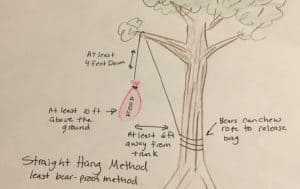
How To Hang A Bear Bag Using The Counter Balance Method (CBM)
The counterbalance method is more effective because it removes the weight of the bag from the rope hanging down. Even if a bear chews or messes with that rope, it won’t cause your bear bag to come down.
CBM uses two bags of similar weight to counterbalance each other from a tree limb. It requires that you choose a tree branch higher than one needed with the straight method. You need a branch that’s high enough for you to pull the first bag high while you attach the second bag. Then the first bag can be lowered and the second bag raised so both are at least 10 feet above the ground.
- Throw the rope and weigh over a tree branch at least 4 feet from the trunk of a tree
- Attach the first bag to the rope using a carabiner
- Pull the bag high until it is nearly as high as the branch
- The branch should be at least 20 feet above the ground
- Attach a carabiner to the rope using the butterfly knot or other knots that securely tie the carabiner
- Attach the second bag to the carabiner
- Toss the second bag into the air. The weight of the first bag will cause it to lower so both bags hang above the ground
- Both bags should be at least 10 feet above the ground
- Remaining rope can be tied above the ground so animals can’t reach it
- The rope that hangs from the second bag is not weight bearing
Some people will throw the first bag over the branches and skip using a rock to pull the rope down. The bags can also be lowered or raised using a stick. This can reduce the length of rope needed, but does take more time usually.
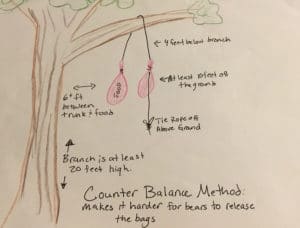
How To Hang A Bear Bag Using The Pacific Crest Trail Method (PCT)
The Pacific Crest Trail Method is used most often by backpackers and hikers who are traveling light and may not have two bags to hang. It is as effective as CBM.
PCT feeds the rope through the carabiner and uses a stick to jam the rope and act as the “counterweight.”
- Throw the rope over the tree and attach your bag using a carabiner
- Thread the rope back through the carabiner so that it makes a loop around the tree branch
- Raise the bear bag up to the branch
- Reaching as high as you can, attach a stick to the rope
- Allow the bag to come back down until the stick jams the rope at the carabiner
- It is now acting as the “counterweight”
- Tie the remaining rope off above the ground
This is an effective method for light travelers and requires less rope than the two tree method while being more effective than the straight hang method.
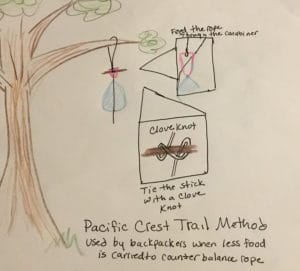
How To Hang A Bear Bag Using The Two Tree Method
The two tree method is usually used when a good tree can’t be used for the other methods. Perhaps the trees you have available are smaller and don’t have as strong of branches that extend out from the trunk.
You can use the two tree method to secure your bag with less-desirable trees so that the bag is still away from the trunk of the tree and out of a bear’s reach. You will need much more rope for this method.
- Throw a rope over the first tree branch and attach the bag to the carabiner
- Throw a second rope, or the other end of the first rope over the second tree
- Tie the end of the rope going over the second tree to the carabiner
- Pull the bag up to the first tree. It should still hang at least 4 feet down from the first branch
- Secure the first rope off by tying it off
- Pull the second rope so that the bag is pulled away from the first tree and suspended between the two trees
- Tie off the second rope
This method usually takes more time, depending on your rope-throwing skills. It also requires more rope so plan ahead and bring extra rope in case you need to use it.

Protect Food By Sleeping On It
This method seems to be popular in bearless areas when your food only needs to be protected from mini bears and other animals.
You basically use your food pack as a pillow and sleep on it. It tells other animals that the food is yours.
It will keep some of the mini bears and other curious animals away. But, in some areas where rodents and animals are more used to people, it won’t stop some inspection.
You may end up with mice and other animals scurrying around your head and sleeping area. But, it is the most convenient of the methods and often works well for long cycle trips or backpacking adventures.
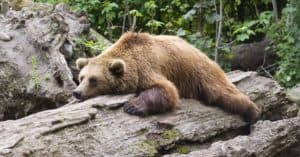
Related Questions
How dangerous are bears? Most bears are not dangerous to people. They like to avoid humans and will stay away. Many hikers and campers come close to bears without ever realizing they came close to bears. If you use common sense, you can stay clear of bear encounters and stay safe. Make noise and avoid surprising a bear. Never get between a mama and her cub. Store all food, trash, and cosmetics away from your tent. Cook away and downwind of your tent. Even if bears wander through the camp, they won’t associate your tent with food if you don’t have smelly products in the tent.
Don’t worry or be fearful. Bear country is lovely wilderness that you wouldn’t want to miss!
Can I share my food with wildlife? It is absolutely vital that people not share their food with wildlife. Whether it is birds and squirrels or large animals, sharing people food endangers the wildlife.
Animals that become adjusted to people also become dependant on them. They are more likely to be killed by accident or necessity. Small animals may cease to sense danger and place themselves in the path of cars or other dangers.
Large animals become a danger to people and must be dealt with by officials. This often means death.
How do I scare a bear away? Bears are usually non-aggressive. Grizzly bears are an exception. Keep a flashlight and bear spray on you. For most bears, wave your arms and make a lot of noise. Make yourself look larger and more menacing. Avoid eye contact. When hiking, be noisy and most bears will move away. Do NOT run away. This triggers their predator instinct. Back away slowly while facing the bear.
